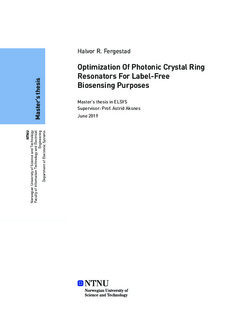| dc.description.abstract | Photonic crystals (PC) are materials with sub-wavelength permittivity variations. They exhibit interesting optical properties in terms of dispersion characteristics and light con- finement. Their optical properties are interesting for photonic integrated circuits.
This thesis work investigates photonic crystal ring resonators (PCRR) in triangular air- hole PC slab for label-free biosensing. The thesis work contains simulations, fabrication, and characterization of PCRRs.
Simulation is performed in software such as MIT Photonic Bands (MPB) for frequency domain solved (FDS) dispersion relations, and MIT electromagnetic equation propagation (Meep) for transmission and mode simulations. PCRR configuration is optimized to pro- duce high quality-factor (Q-factor) mode simulated PCRRs.
Optical devices such as strip waveguides and line defects in PC support light coupling to PCRRs. Strip waveguides and line defects are therefor simulated as stand alone struc- tures. triangular air-hole PC, strip waveguide, and line defect are simulated with MPB in both two and three dimensions. Guided modes in strip waveguide and line defect are found to match the band-gap of triangular air-hole PC. Transmission simulations are per- formed in two and three dimensions. Three dimensional simulations are run on Fram, a super computer. Two-dimensional transmission spectra exhibit sharp resonances in the band-gap. The resonances are fewer and less sharp for three-dimensional simulations. Mode simulations coincides with transmission simulations. Highest achieved Q-factor for two-dimensional simulations is 5.7×108. For three-dimensional simulations the highest achieved Q-factor is 59871.
Fabrication of PC structures is performed using plasma enhanced chemical vapor de- position (PECVD) for thin film growth, electron beam lithography (EBL) and mask less aligner (MLA) for exposure, and inductively coupled plasma-reactive ion etching (ICP- RIE) for etching. Both crystalline-Silicon (c-Si) and amorphous-Silicon (a-Si) devices are fabricated. a-Si devices are fabricated with light coupling variations in form of inverted tapers.
Characterization of fabricated devices is performed by tunable laser measurements in a drop-filter transmission configuration. c-Si devices exhibited better transmission perfor- mance than a-Si devices. The highest measured Q-factor value for fabricated devices was 25739. | |
